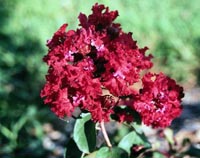Resource Library
Plant of the Week: "Dynamite" Crapemyrtle
The University of Arkansas System Division of Agriculture does not promote, support or recommend plants featured in "Plant of the Week." Please consult your local Extension office for plants suitable for your region.
Plant of the Week
"Dynamite" Crapemyrtle
Latin: Lagerstroemia indica

Crapemyrtles selections are a dime a dozen. There are hundreds of them, and to have one that truly stands out from the crowd is unusual.
Dynamite Crapemyrtle, with the brightest red flowers of any crapemyrtle selection, is one of these standouts.
Dynamite crapemyrtle is such an outstanding plant that it was selected as a 2002 Arkansas Select plant. Arkansas Select plants are chosen by the green industry and University of Arkansas experts for their outstanding ornamental qualities and widespread adaptation across the state. It is available from nurserymen throughout the state.
Dynamite, a selection of the traditional crapemyrtle species - Lagerstroemia indica - found all across the South, is a typical tree-type plant capable of reaching 20 feet or more in height. It has an upright branching habit with a spread of 8 feet. On mature trees, the trunk will be smooth and tan colored.
The leaves of this crapemyrtle carry on the theme of red by emerging in the spring suffused with crimson. As the summer advances, they turn to green.
The bright red, some describe it as a cherry red, flowers appear in midsummer on terminal shoots in panicles capable of reaching a foot in length. The dark red, crape-like blooms occasionally are flecked with a few petals of white, which only serve to heighten the intensity of the red.
Crapemyrtles have been grown in the U.S. since the days of the American Revolution and were well established on plantations throughout the South before the Civil War. It was introduced from China, even though Linnaeus got it wrong when he gave it the species epitaph of indica. Crapemyrtle is a quintessential southern plant, growing wherever cotton flourishes.
Prior to the 1950s, crapemyrtles were a nameless commodity in the nursery trade, sold primarily by color such as pink, white, or the old favorite, watermelon red. Since that time, crapemyrtle breeding and selection has become an obsession of southern nurserymen and the marketplace has been flooded with named selections.
Dynamite crapemyrtle was developed by Carl Whitcomb, a horticulture professor at Oklahoma State University who gave up on academia to pursue a career as a nursery consultant and inventor. Whitcomb has patented several items used widely in the nursery industry, including the field-grow bag, a special nutrient supplement to add to pine bark media to provide all needed micronutrients and several others.
Dynamite was one of Whitcomb's first entries in the field of plant breeding and has become his most successful. Ever the tinkerer, Dynamite was developed by using a chemical mutigen to force changes at the gene level. The occasional flecks of white in the petals are an indication that there may be vestiges of a chimeral background in the plant.
As a crapemyrtle Dynamite is considered one of the best because of the bright red flowers and its superior powdery mildew resistance. Like all crapemyrtles, it has outstanding drought tolerance.
Dynamite was selected on Whitcomb's farm near Stillwater, near the northern limits where crapemyrtle will grow so it should have good winter hardiness.
Crapemyrtles in the northern part of Arkansas will often freeze back once every 10 to 20 years, so the full mature height of a selection is seldom achieved in the Ozarks. It should be planted where it gets full sun.
By: Gerald Klingaman, retired
Extension Horticulturist - Ornamentals
Extension News - July 12, 2002
The University of Arkansas System Division of Agriculture does not maintain lists of retail outlets where these plants can be purchased. Please check your local nursery or other retail outlets to ask about the availability of these plants for your growing area.